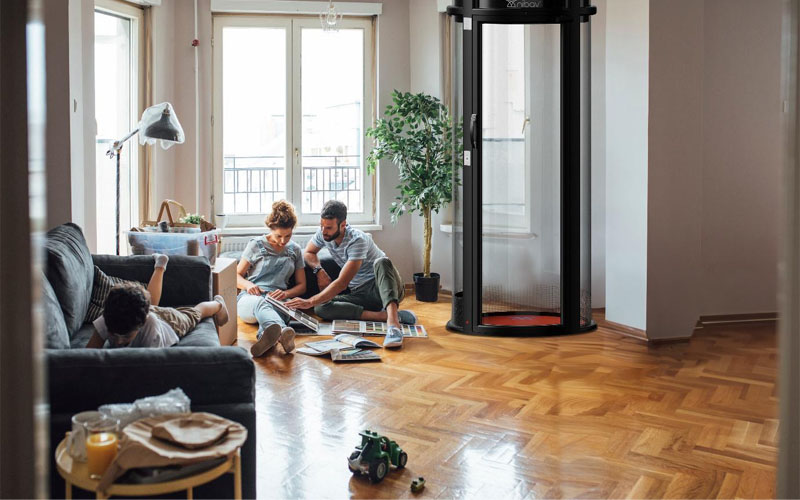Installing a residential elevator can greatly improve accessibility and convenience in your Canadian house. However, any significant home improvement decision necessitates thorough evaluation of the variables that will influence the entire cost of home lifts. This detailed article examines the important factors to consider when budgeting for a house elevator.
Why Install a Home Lift?
A residential elevator provides life-changing benefits that can significantly improve your daily experience at home. Key benefits include:
Enhanced Mobility: An elevator allows homeowners with mobility concerns or physical challenges to easily go vertically within a multi-level home. This encourages independence while reducing reliance on others.
Increased Safety: An elevator is a safer, more stable alternative to stairs, lowering the risk of serious falls. The confidence of safe access provides peace of mind.
Improved Accessibility: Level entry into each story without the need for stairs provides easy access for people with mobility issues. This promotes aging in place.
Luxurious Convenience: For all homes, an elevator provides a touch of grandeur and distinction while allowing for easy access between floors. This convenience improves daily life.
Nonetheless, purchasing a Nibav Home Elevators Canada may be a great option for a lot of homeowners. The long-term advantages and possible rise in property value could make the initial outlay worthwhile.
Top 10 Cost Factors for Home Lifts
While the benefits are numerous, a house elevator requires a hefty investment. Several important aspects determine the overall cost of house lifts, including:
Size and Weight Capacity:
The physical dimensions and weight capacity required for your residential elevator influence the price. Standard models range in size from tiny 3-4 person to more expansive 8-12 person configurations. The larger the cab, the greater the manufacturing and installation costs. Higher weight capacities necessitate a more powerful mechanical system to securely lift heavier weights. Common capacities range from 750 pounds to 1500 pounds. Expect to pay more for a larger capacity house elevator.
Design & Materials:
The design options, finishes, and construction materials used can all have an impact on the elevator’s visual appeal, longevity, and overall cost. Choosing premium materials like as glass, aluminum, and stainless steel can greatly boost the entire cost. Internally, the cab can be customized with features such as flooring, lighting, wall panels, and handrails. Choosing improved fixtures improves both the elegance and the pricing.
Installation requirements:
The complexity of installation based on your existing home’s structure influences total pricing. Elevators may require structural reinforcing, new electrical systems, and the construction of a hoistway or elevator shaft. Labor costs are kept low by requiring minimal preparation and making basic connections. Existing circumstances that allow for simple installation make a lift more economical.
Drive System and Travel Distance:
The cost is influenced by the type of drive system used (hydraulic, cable, or air-powered) and the distance traveled between floors. Because of their ease of installation, air-powered elevators may be less expensive. Longer travel distances necessitate more powerful driving systems and stronger lift ropes, resulting in higher costs. When determining costs, take into account your home’s layout.
Customization Extras:
Personalized options tailored to your preferences enable a one-of-a-kind house elevator. This customisation increases the project cost. Rich wood panels, indirect lighting, wallpaper, floor medallions, music systems, video screens, and other options enhance the experience but come at a higher cost.
Specialty Design Elements:
- Unique elevator designs to satisfy unique needs increase prices.
- Outdoor/open-air lifts provide panoramic vistas, but require weatherproofing and code compliance.
- Glass window enclosures improve aesthetics yet requiring engineering for safety.
- Curved or angular interior spaces necessitate precise custom manufacturing.
- Two or three entry layouts can allow wheelchairs, although they complicate installation.
Safety and Accessibility Features:
Home Elevators are designed with safety in mind. Consider adding video monitoring, emergency call systems, battery backups, door sensors, and ADA compliance features. While crucial for security and accessibility, these sophisticated features necessitate additional hardware, electronics, and programming. Weigh priorities against costs.
Speed and Driving System:
Faster lift speeds necessitate more robust drive systems, which raises costs. Residential elevators typically travel 30-40 feet per minute. Options for high-speed models range from 60 to 150 fpm. Aside from speed, the choice of hydraulic, cable, or pneumatic drive has an impact on overall pricing due to various engineering demands.
Location-Based Factors:
Pricing variables are influenced by the geographical location of installation:
- Shipping/transportation costs in the region
- Local labor and technician rates.
- Permitting, inspection, and licensing fees
- Sales tax and insurance requirements.
Investigate location-specific expenses that increase the overall budget.
Maintenance Plans:
Ongoing maintenance by a skilled elevator firm assures the best performance and lifespan. Prepare for:
- Annual safety inspections.
- Regular cleaning and lubrication
- Our services include component testing and 24-hour repair programs.
Consider maintenance package prices upfront, or expect greater à la carte payments in the long term.




